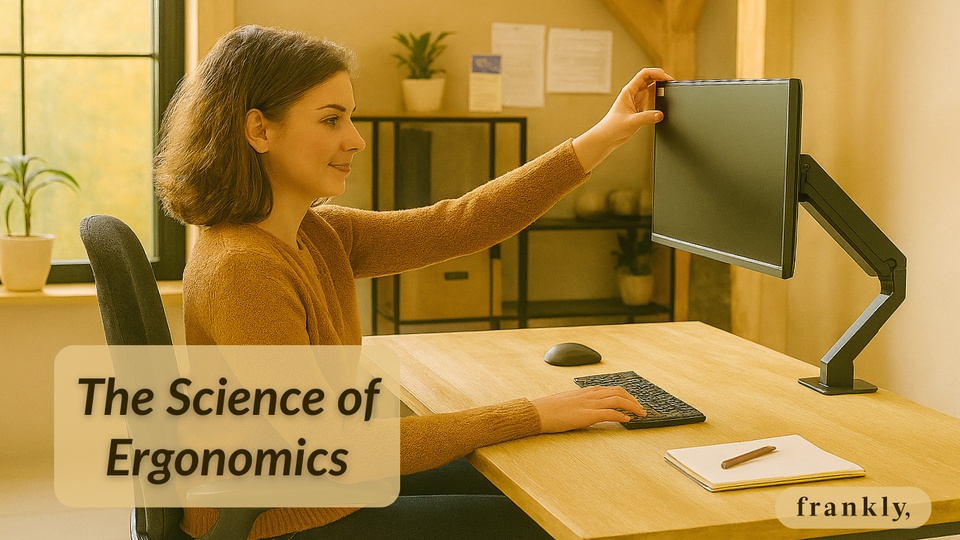The Science of Ergonomics: Small Adjustments Create Big Wellness Wins

It's become a cliche that office workers are stiff, but that stereotype is rooted in reality. Aches and pains are common from a sedentary, desk-based work lifestyle.
Most people accept discomfort as just a part of the job, but the science of ergonomics shows otherwise.
Ergonomics isn't only about furniture– it's about designing environments that support the body and mind so people can work with their biology, not against it.
This blog explains:
- What ergonomics is and what it means for our bodies
- The overlooked connection between mental and physical health
- The future of physical wellness through ergonomics
The Science Behind Ergonomics
Ergonomics is the study of how people interact with their environments, where physical ergonomics takes human anatomy into account and cognitive ergonomics studies mental processes in an environment. Ergonomics centers the person in the environment, making the physical space, tools, and tasks fitted to the human body rather than vice versa.
Creating optimal comfort, safety, and performance is central to ergonomics. When we sit too long, small physical stresses add up. Over time, poor posture, awkward wrist positions, and repetitive motions cause muscle strain and chronic pain. The body then begins to compensate in response to this pain and strain– shoulders hunch, lower backs tighten, and circulation slows throughout the body.
The effects don't stop there; physical discomfort increases the production of cortisol, the body's stress hormone, which can heighten anxiety and reduce concentration. In other words, an uncomfortable chair can actually add to your mental fatigue.
According to OSHA, ergonomics is crucial to preventing musculoskeletal disorders (MSDs), which are often caused by working in awkward body postures or consistently performing the same repetitive task. Workers report a 40% decrease symptoms after adopting ergonomically-driven setups.
The science is clear: physical comfort and alignment supports mental clarity.
Ergonomics and Mental Health: Overlooked Connections
Studies show that the relationship between the body and the mind runs deep, deeper than we recognize on the surface. When our bodies are under strain, even minor tension sends signals of discomfort to the brain, creating a constant background noise of stress. The body-mind feedback loop makes it harder to focus, process emotions, and think creatively in ways we don't realize.
So, how can you bridge that gap between your mental and physical environments? Try these 3 strategies:
- Optimize your desk setup
Your chair should allow your feet to rest flat on the floor, with your knees roughly creating a 90-degree angle so that your thighs are parallel to the floor. A footrest or stool are great tools to help achieve this. Ensuring your feet are properly placed ensures you protect your circulation while you sit.
Adjust your monitor so it sits at your eye-level about an arm's length away. Keep wrists resting neutrally on your desk, and keep your elbows close to your body to prevent strain while working. Consider using an external keyboard and mouse if you work with a laptop to allow for a more comfortable setup. Eye strain is a common complaint in office workers, so don't forget to use the 20-20-20 rule: take a 20-second break every 20 minutes to look at something 20 feet away. In these breaks, consider moving your body and employing some of the micro-break strategies we recommend.
- Rethink lighting
Natural light supports the body's circadian rhythms, the internal clock that regulates sleep cycles. If possible, work near a window, use daylight-balanced lightbulbs, or take quick breaks to get outside. Your body relies on the sun to regulate its circadian rhythm, so lighting is not inconsequential when considering how our bodies are impacted by our workspaces.
- Build movement into your routine
Even the best ergonomic setups can't replace physical movement. Give your body permission to move throughout the day. Set a timer to stand or stretch every 30-45 minutes. If you can, alternate between sitting and standing so you can stimulate circulation and reduce tension. As we've discussed, supporting physical wellness in turn supports mental wellness, and movement throughout the day can reinforce focus cycles.
While you're seated, remember to stretch your hands, wrists, arms, and shoulders from time to time. Even small, innocuous actions can help prevent lasting damage and strain.
The Future of Ergonomic Wellness
Ergonomics is evolving from a niche design concern to a holistic wellness practice that is dynamic for all sorts of workplaces and work circumstances. Smart chairs and posture-tracking wearables are helping workers monitor alignment in real time. Digital reminders encourage workers to get up and move throughout the day, and wearable devices facilitate personalized wellness. Artificial intelligence (AI) can provide personalized posture analysis and recommend dynamic workstations that adapt to a user's needs, and workstations will become more adaptable to the individual as ergonomics is seen as a proactive way to prevent and mitigate risks of injury or strain.
But, technology isn't a full solution. The future of ergonomic wellness also depends on inclusion– designing spaces that support neurodiverse and mobility-diverse employees. Adjustable desks and flexible layouts ensure everyone can thrive.
Ultimately, it's time to encourage setting ourselves up for success. Wellness-centered design is becoming a standard, not a perk, and companies that embrace it are seeing stronger engagement, lower burnout rates, and happier teams.
Small Changes, Big Impact
Ergonomics isn't just about comfort, it's about caring for the body that carries you throughout your life. When your environment supports you, you think more clearly, move more freely, and feel more energized.
As you sit (or stand) at your desk today, take a moment to notice how your body feels. What's one small adjustment, if necessary, that could make your workday easier? Wellness starts in the small, intentional actions in the quiet science of alignment.
Author: Reagan O'Brien
Resources
Movement Improves Employee Wellbeing

Comments ()